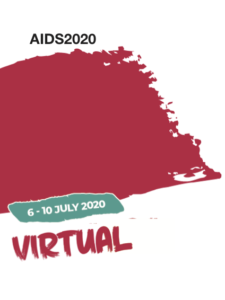Obesity linked to dolutegravir, especially with TAF, could increase risk of adverse pregnancy outcomes
22 July 2020. Related: Conference reports, Women's health, Pregnancy, Side effects.
 Polly Clayden, HIV i-Base
Polly Clayden, HIV i-Base
Treatment-emergent obesity with tenofovir alafenamide (TAF)/ emtricitabine(FTC)/dolutegravir (DTG) and to a lesser extent, tenofovir disoproxil fumarate (TDF)/FTC/DTG, could increase the risk of adverse pregnancy outcomes in black women. This is according to modelled predictions that were presented at AIDS 2020 by the ADVANCE study investigators. [1]
DTG and other integrase inhibitors are associated with significant weight gain. This is higher when DTG is used with TAF. Increases in body weight are also associated with female sex and black ethnicity.
Pregnant women who are clinically obese have a higher risk of adverse outcomes – both for the mother and the infant.
Short term results from studies of TAF/FTC/DTG in pregnancy have not shown significant increases in adverse birth outcomes.
The aim of the study was to look at whether there is an increased risk of adverse birth outcomes if women become obese after long-term ART.
The ADVANCE study found significant treatment-emergent obesity after 96 weeks of treatment, most notably among black women receiving TAF/FTC/DTG (these results were also presented at AIDS 2020). [2, 3]
Fourteen per cent of women receiving TAF/FTC/DTG, 8% receiving TDF/FTC/DTG and 2% TDF/FTC/EFV, with normal BMI at baseline, developed treatment emergent obesity at week 96 in ADVANCE.
The authors ran a systematic review evaluating the association between pre-pregnancy obesity and adverse pregnancy outcomes.
They calculated the relative risk (RR) for each adverse outcome in women with obese (30 kg/m2 and above) compared with normal BMI (18.5–24.9 kg/m2). BMI was measured at or before 16 weeks of gestation. Adverse pregnancy outcomes were those most frequently occurring in standard clinical practice.
To model the risk prediction, 1000 pregnant women with normal baseline BMI were allocated to each treatment arm of ADVANCE: TAF/FTC/DTG, TDF/FTC/DTG and TDF/FTC/EFV.
The ADVANCE treatment-emergent obesity rates were applied to the model to calculate the number of obese and normal BMI women at 96 weeks.For each adverse birth outcome, treatment emergent obesity at week 96 were combined with RR for obese versus normal weight pregnant women. The resulting predications for maternal and infant adverse pregnancy outcomes are shown in Table1.
Table 1: ADVANCE trial: predicted increased risks of adverse pregnancy outcomes (per 1000)
| Baseline | TAF/FTC/DTG 96 weeks | TDF/FTC/DTG 96 weeks | TDF/FTC/EFV 96 weeks | |
| Adverse maternal outcomes | ||||
| Preterm delivery | 70 | 73 (+3) | 71 (+1) | 70 (0) |
| Gestational hypertension | 28 | 39 (+11) | 34 (+6) | 29 (+1) |
| Gestational diabetes | 16 | 23 (+7) | 19 (+3) | 16 (0) |
| Pre-eclampsia | 25 | 35 (+10) | 30 (+5) | 26 (+1) |
| Postpartum haemorrhage | 112 | 115 (+3) | 114 (+2) | 112 (0) |
| Caesarean section | 213 | 232 (+19) | 224 (+11) | 215 (+2) |
| Total effect | +53 | +28 | +4 | |
| Adverse infant outcomes | ||||
| Small for gestational age | 89 | 87 (-2) | 88 (-1) | 89 (0) |
| Large for gestational age | 134 | 154 (+20) | 145 (+11) | 137 (+3) |
| Macrosomia | 31 | 37 (+6) | 34 (+3) | 31 (0) |
| Stillbirth | 4 | 4 (0) | 4 (0) | 4 (0) |
| Neonatal death | 2 | 2 (0) | 2 (0) | 2 (0) |
| Neural tube defect | 0 | 0 (0) | 0 (0) | 0 (0) |
| Total effect | +24 | +13 | +3 | |
The model predicted a higher risk of adverse pregnancy outcomes with DTG regimens compared to TDF/FTC/EFV. This was most notable with TAF/FTC/DTG.
The authors noted that the increase in adverse pregnancy outcomes at week 96 with TAF/FTC/DTG was almost double that of TDF/FTC/DTG.
They added that these risks could increase further for women treated longer-term – the risk of clinical obesity continues to rise after week 96 in ADVANCE.
comment
Although results from the VESTED trial – presented earlier this year at CROI – found TAF/FTC/DTG to be associated with significantly fewer adverse pregnancy outcomes than TDF/FTC/DTG or TDF/FTC/EFV (driven by lower rates of preterm delivery and small for gestational age) and fewer neonatal deaths than TDF/FTC/EFV, women in this study started ART in pregnancy so were taking it for a comparatively short time before delivery. [4, 5]
The model suggests that risks and benefits might be less clear for pregnant women who have received TAF/FTC/DTG longer-term.
References
Unless stated otherwise, references are to the programme and abstracts of the AIDS2020 virtual conference, 6–10 July 2020.
- Hill A et al. The predicted risk of adverse pregnancy outcomes from treatment-induced obesity in the ADVANCE trial. AIDS 2020 virtual. 6–10 July 2020. Oral abstract OABLB0103.
https://cattendee.abstractsonline.com/meeting/9289/presentation/3499 - Clayden P. ADVANCE 96-week results: dolutegravir weight gain continues, especially in women and when used with TAF – no evidence of a plateau. HTB. 16 July 2020.
https://i-base.info/htb/38493 - Venter F et al. The ADVANCE trial: phase 3, randomised comparison of TAF/FTC+DTG, TDF/FTC+DTG or TDF/FTC/EFV for first-line treatment of HIV-1 infection. AIDS 2020 virtual. 6–10 July 2020. Oral abstract OAXLB0104.
https://cattendee.abstractsonline.com/meeting/9289/presentation/3498 - Clayden P. Dolutegravir-based ART is safe and effective for pregnant women: first results from the VESTED trial. HTB. 17 April 2020.
https://i-base.info/htb/37534 - Chinula L et al. Safety and efficacy of DTG vs EFV and TDF vs TAF in pregnancy: IMPAACT 2010 trial. AIDS 2020 virtual. 6–10 July 2020. Oral abstract 130LB.
http://www.croiconference.org/sessions/safety-and-efficacy-dtg-vs-efv-and-tdf-vs-taf-pregnancy-impaact-2010-trial (abstract)
http://www.croiwebcasts.org/p/2020croi/croi/130 (webcast)

